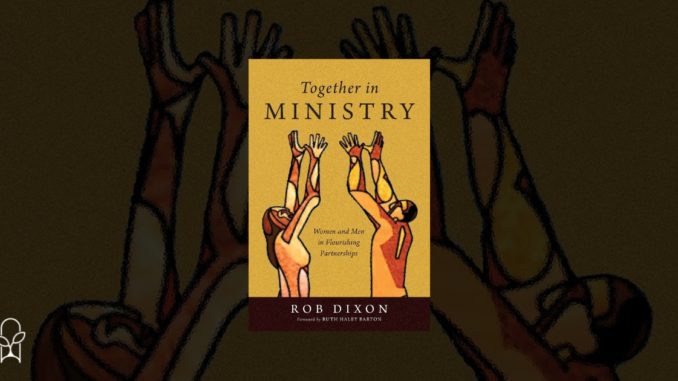
Published by IVP Academic on September 28, 2021
Genres: Academic, Non-Fiction, Christian Life
Buy on Amazon
Goodreads

Women and men are designed to work together in fulfilling God's mission on earth. Yet God's original intent for equal partnership has been so distorted that churches and organizations continually struggle to foster healthy mixed-gender ministry collaboration. Is it even possible to return to the Genesis ideal of co-laborers in today's contexts? Longtime ministry leader Rob Dixon knows it's possible--though it takes intentionality, courage, and wisdom. Based on qualitative field research among ministry practitioners, Together in Ministry offers a prophetic roadmap for individuals and communities as they seek to develop flourishing ministry partnerships for women and men. Organized around the key domains of inner life, community culture, and intentional practices, this model identifies ten key attributes of partnerships that are both personally satisfying and missionally effective. For each attribute Dixon presents research findings and biblical examples, along with benefits, barriers, and practical next steps. With plenty of real-life stories from ministry leaders and reflection questions in each chapter, Together in Ministry casts a compelling--and encouraging--vision for flourishing partnerships and equips teams and individuals with next steps for making that vision a reality.
At the beginning of Billy Graham’s ministry in the 1940s, he instituted what would become known as the “Billy Graham Rule.” The rule was simple: never be alone with a woman. The intentions were good, I’m sure, but the consequences of that rule, the patriarchal culture in which it was created, and the purity culture which it helped create have kept women from positions of power and influence, robbed men of fruitful friendships and partnerships, and inhibited human flourishing as God intended. That’s the overall thesis of Rob Dixon’s Together in Ministry: Women and Men in Flourishing Partnerships.
Dixon writes as an associate regional ministry director with InterVarsity Christian Fellowship/USA and a senior fellow for gender partnership with the InterVarsity Institute. (Unsurprisingly, Together in Ministry is an InterVarsity Press publication.) His academic specialty is the development of mixed-gender ministry partnerships. All that to say, while this is a book that could have been written by a number of people, Dixon is uniquely situated to bring in real-world data and stories to add a practicality to the work.
Together in Ministry builds off of Dixon’s doctoral work and that is possibly the book’s greatest weakness. While it is an academic title and the book has been adapted from the format of a dissertation, there is still a repetitive sameness to the writing format that, while suitable for a dissertation, comes across as very regimented and stilted. The sameness of the structure—“First…second…third…lastly…”—meant that I kept finding myself distracted and pulled away from the reading. So, while the strength is that it provides a clear blueprint, its weakness is that it isn’t always compelling reading. But that’s the only real criticism I have and I’m fully aware that it’s a personal preference. (It might be because, as someone working on my own doctoral dissertation, anything that reads like what I’m already spending an inordinate amount of time on just feels exhausting.)
Dixon’s research led him to ten different attributes of flourishing mixed-gender ministry partnerships. I won’t provide a detailed discussion of each one, but will list them all out and talk about the highlights:
- Both members are committed to maintaining the posture of an authentic learner.
- Both members have a shared theological conviction that God honors the full and equal partnership of men and women.
- There is a deepening awareness of personal gender brokenness.
- Flourishing partnerships embody a vision for freely shared power.
- Both members believe that embracing difference advances their mission.
- Mixed-gender ministry partnerships are simultaneously thriving friendships.
- Flourishing partnerships thrive when teams and communities cultivate sensitivity to gender dynamics.
- There must be abundant communication.
- There must be contextualized interpersonal boundaries, tailored for each particular partnership.
- There must be a public dimension to the partnership.
Together in Ministry divides these ten attributes into three parts: Inner Life (1-3), Community Culture (4-7), and Intentional Practices (8-10). Dixon offers a 10-12 page chapter on each, then wraps things up with a concluding summary chapter.
Most of Dixon’s points are just common sense. Mixed-gender ministry partnerships won’t flourish if one party doesn’t believe in the full inclusion of women in ministry. Duh. These partnerships will also be hampered if either side isn’t adaptable and willing to learn and grow. Also duh. There must be a willingness to share power. And…well, that moves from what makes sense to what is actually practiced. Many individuals who would claim the first two, would embrace women as equals in ministry, still, consciously or subconsciously, keep power away from women.
Probably the most obscure of Dixon’s points is “embracing personal gender brokenness.” By this, Dixon simply means that we are aware of struggles in our lives that stem from our experiences as women or men, whether personal or cultural. An understanding of one’s self and how one’s gender affects one’s struggles is helpful in building cross-gender partnerships.
Overall, Together in Ministry does a sufficient job of outlining the problem and detailing the attributes seen in the solution, but the journey from one to the other is less clear. While each chapter does contain a section on benefits of and barriers to the growth discussed in the chapter, Dixon doesn’t go into much detail of how those barriers can be overcome. It’s a great starting toward, it’s a good foundation, but a lot more work must be done.
